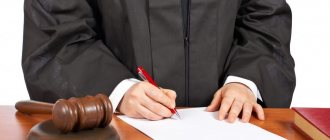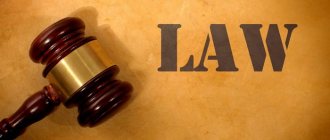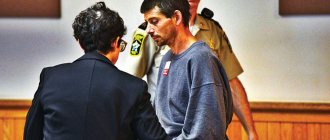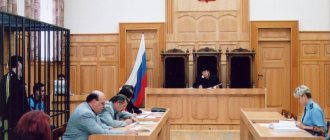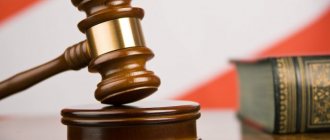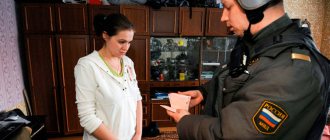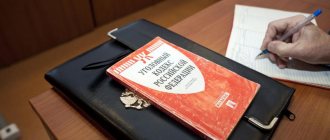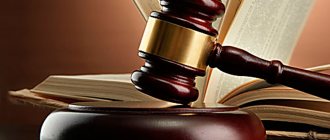What is the article of the Code of Criminal Procedure about?
Inspection in criminal proceedings is one of the most common investigative actions, as in every procedural event. And to carry out an inspection, certain rules must be followed.
Compliance with a number of conditions will ensure the reliability of the protocol description of what was observed and discovered, and will also eliminate the possibility of document forgery and substitution of material evidence. Inspection tactics play a significant role in the science of forensics.
During the event, the investigator must draw up a protocol showing all the objects examined and studied. If the protocol is drawn up incorrectly or doubts arise about its reliability, then it will not be possible to dispel these doubts, and the evidence found will be considered inadmissible.
In the case of road traffic accidents, inaccuracies in the protocol also entail doubts about the reliability of the conclusions of the automotive technical examination, which are fundamental in these violations of the law. To avoid such situations, the legislator developed Article 177, which clearly reflects the basic principles of the procedure.
Basic provisions
The inspection can only be carried out by competent persons - an investigator or an inquiry officer in the presence of special circumstances. Mandatory participants in the procedure, in addition to law enforcement officers, are witnesses, persons related to the home, representatives of the organization in which the premises are inspected, as well as a lawyer and the accused, if the event is held after the initiation of a criminal case.
Optional participants, such as special experts, witnesses, the victim, an interpreter and other independent specialists, may also participate in the examination.
Separately, I would like to note the witnesses, because without them this investigative action cannot be carried out, except for the cases provided for in Part 3 of Art. 170 Code of Criminal Procedure of the Russian Federation.
Witnesses can only be adults who are not related to any of the parties to the crime. The selection of witnesses is a very important procedure, because after their testimony they will be able to confirm the facts regarding the procedure. They act as a kind of guarantor of the correctness of the inspection.
During the event, the investigator or another person carries out measurements, photographs, video recordings, sound recordings, and also draws up plans and diagrams, makes casts and impressions of traces. All found objects that are important for the investigation are initially presented to those present, and then sealed and confiscated. When inspecting a home, the owners must be present, and photography and video filming can only be done with their consent.
If it is impossible for the owner of the property or an adult living in it to be present, a representative of the housing fund or a local deputy is invited for investigative measures. Inspection of commercial organizations and enterprises takes place in the presence of the administration.
Types of inspection
The basis for conducting this investigative proceeding is a decision of the investigator, inquiry officer or prosecutor. The procedure can be carried out both before the initiation of the case and after it.
It is very important to distinguish between an inspection and a search. In the first case, the study of objects occurs to record the crime scene and detect traces of the crime. In the case of a search, a search is made for the crime weapon and other items that may be important to the investigation.
The procedure and purpose of the inspection of the crime scene according to the Code of Criminal Procedure of the Russian Federation
The inspection procedure in criminal law is divided into several types:
- By objects of inspection:
- the scene of the incident;
- homes;
- corpse;
- objects and documents;
- pets;
- Vehicle;
- premises and areas that are not the scene of the incident;
- plants;
- examination.
- According to the sequence of the investigative examination:
- initial;
- repeated.
- By volume of investigative inspection:
- basic;
- additional.
Each type has its own characteristics and carries a certain importance, but the principle is the same for all. Inspection of traces is carried out at the site of the investigative measure. If this action requires a long time or the study of objects at the scene of the investigation is difficult, then the objects are seized, packaged and sealed.
The seized items are also confirmed by the signatures of the investigator and witnesses present at the scene. The protocol must indicate the seized items, as well as the time and place of their seizure.
The document must also reflect:
- the actions of the investigator in the sequence in which they were performed;
- research results;
- time, weather, lighting, as well as technical means used by the investigator during the event;
- information about the packaging and sealing of seized items;
- data on the location of the corpse and other objects relevant to the criminal case;
- data of witnesses.
If photo or video equipment was used during the proceedings, then data about this must also be included in the protocol. The presence of additional specialists (doctor, translator), as well as other participants in the process, is also documented.
There must be a resolution for each type of inspection, but in some cases, when there is information that evidence may be destroyed, investigative actions are carried out on an emergency basis, that is, without the consent of, for example, the owner of the home. In this case, the investigator applies for a ruling to the judge, who gives his consent to the procedure in the form of an appropriate warrant.
Concept and types of inspection
This is one of the types of investigative actions, and it consists of finding and examining things that may be important for the investigation of the incident. In other words, the main purpose of an examination is to gather sufficient evidence through observation.
Important! The essence of the procedure is not determined by the direct seizure of things, but only by studying the situation and assessing it.
There are several types of inspection:
- the scene of the incident;
- external examination of the body of the deceased;
- things/documents;
- animals;
- exhumation of the body;
- areas of terrain and premises;
- examination.
Comments on Article 177 of the Code of Criminal Procedure
The examination of objects and documents of the Criminal Procedure Code allows only the investigator and interrogating officer, but the examination of a corpse has significant differences and implies a different procedure for carrying out the activity.
In legal terminology, an examination of the body is called an examination. It is carried out in order to detect traces of violent acts and identify characteristic evidence of a crime. Taking into account the fact that the examination affects the individual’s right to integrity and freedom, it is singled out as an independent investigative measure.
The procedure is carried out exclusively in relation to the accused, suspect, witness or victim. None of the participants in the process is subject to examination anymore. A separate resolution is required to conduct an inspection; it differs from a resolution to inspect housing or other objects.
During the examination, actions that humiliate the dignity of the person being examined or are dangerous to his health are not allowed. If the search requires the nakedness of the person being examined, then the investigator must be of the same gender, as well as the witnesses. Sometimes the examination is carried out by a doctor, who may be involved by the investigation as a special expert.
The results of the examination of the body are also recorded in the examination report. The document must be drawn up objectively and competently. It must describe all actions performed on the human body, as well as all traces found in the sequence in which they were found.
The examination can be carried out both in relation to a living person and in relation to a dead person. In the case of an examination of a corpse, it is carried out by a pathologist or forensic expert in a morgue. If in order to examine a corpse it is necessary to remove it from the burial site, permission from relatives is required.
The protocol for examining the corpse indicates whose corpse is being examined, where it was buried, and also for what purposes this action is being carried out. Exhumation may be carried out in order to examine the corpse for identification, as well as to examine the cause of death. The removal of a corpse from the burial site is carried out in the presence of relatives, an investigator, witnesses, and a forensic expert.
Methods of investigation of murders and forensic characteristics
What does judicial practice show under this article?
All investigative measures may be declared invalid in court if the authorized official incorrectly draws up a protocol of inspection and examination. An example of a situation would be an inspection of a crime scene - the accounting department of one enterprise where financial fraud took place.
During the inspection, the investigator seized documents from desks, cabinets and safes in huge quantities. At the court hearing, it was decided to recognize the investigative measures and the evidence found during the proceedings as inadmissible.
The fact is that the investigator was supposed to conduct an inspection, but he conducted a search, and as is known, it is carried out exclusively after the initiation of a criminal case. During the inspection, it is not allowed to remove documentation from locked safes and cabinets. If the documentation had been seized from open cabinets and safes, the court would not have made such a decision, since a large amount of information cannot be processed at the scene.
What decisions are most often made under Article 177 of the Code of Criminal Procedure?
Most often, investigative actions are declared invalid during an examination. In a hurry, investigators quite often forget about the constitutional rights of citizens and make a number of mistakes. The most common case is the examination of a person by an investigator of the opposite sex. Such an action violates the right to honor and dignity of citizens. And any judge will recognize such an inspection without much effort from a lawyer as illegal.
The second most common violation is explaining the rights of inspection participants. Before starting the event, the investigator is obliged to explain to the participants in the procedure their rights; if he does not do this, but immediately begins the inspection, then in principle there is no point in completing it, since the order of the procedure was violated from the very beginning.
Taking into account the fact that most often they conduct an investigation of the crime scene, errors that entail the invalidation of investigative actions also occur when inspecting the suspect’s home. An inspection is not a search, but many investigators, in order to quickly close the case, exceed their powers and carry out the procedure incorrectly. If the home owner’s belongings are damaged during the event, the government agency must compensate their cost at its own expense.
Appealing the inspection results
If citizens do not agree with the outcome of such a procedure, then they have the right to appeal it in the manner prescribed by law. To do this, you will need to file a complaint and send it to the prosecutor or the head of the investigative department.
For this, it is best to seek the services of an experienced lawyer who will help you correctly draw up a document with references to specific articles of the Code of Criminal Procedure of the Russian Federation and violations.
A copy of the protocol received earlier must be attached to the complaint so that the management of the Investigation Department or the prosecutor can familiarize themselves with how the procedure was carried out.
In what cases is the procedure illegal?
An inspection is considered illegal if the conditions listed in Art. 176 Code of Criminal Procedure of the Russian Federation. For example, if there is no reason to believe that traces of an offense will be found.
Also, when inspecting premises, the consent of their owners is required to carry out the procedure. If they do not agree, then the investigator simply does not have the right to carry it out. Otherwise, such an inspection will be considered performed outside the scope of the law.
Note. The exception is the case if the court approved the investigator’s petition filed earlier. Then he will have documented evidence that the court considers the inspection to be completely objective.
During the process, the rights of participants must not be violated. For example, physical force cannot be applied to them, pressure on them in order to obtain information about the location of certain objects that are significant for the investigation of the incident is not allowed.
According to the Code of Criminal Procedure of the Russian Federation, an inspection without the participation of witnesses is not considered illegal if technical means were used to record what was happening.
If the inspection was declared illegal, then it becomes inadmissible evidence. The protocol on it can no longer be used as one of the case materials.
A complaint about an illegal or incorrectly conducted inspection may be submitted to the prosecutor in charge of the case. He will check the legality of the procedure performed and whether it complied with all the standards established by the Code of Criminal Procedure of the Russian Federation. You can also try to appeal the inspection through the head of the inspection authority or the court.
The main thing is to correctly file a complaint and argue why you do not agree with how the inspection was carried out and under what circumstances.

